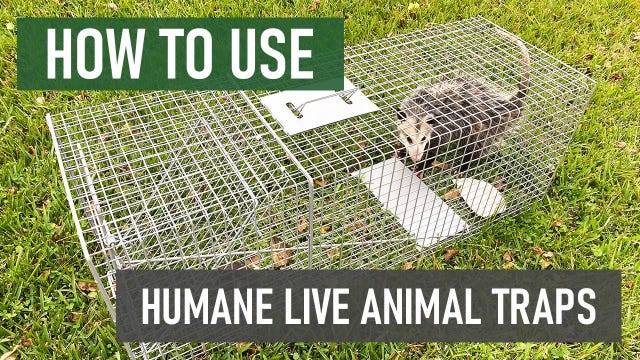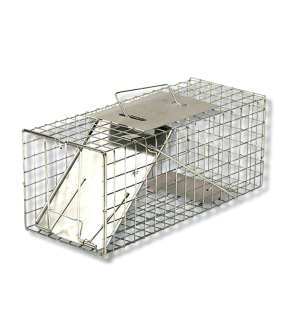Gain access to personalized product screening, the best pricing, rewards, and more!
Most Effective Products
How to Catch a Vole with a Live Trap
Voles are rodents, and they may look like a mouse at first glance. The unfortunate truth about voles is that if you spot one, there is probably more hiding. These tiny pests can cause extensive damage to trees, lawns, and gardens. One method of removing a vole from your property is using a live trap to catch and release the animal. Live trapping is a safe and effective way to keep animals away from your home.
If you want to catch a vole with a live trap, read this guide for instructions and product recommendations.
Identification
Before using a live trap, you must ensure the wild animal you are dealing with is a vole. This will ensure that you are using the correct bait and strategies.

Voles are generally 4 to 9 inches long. They usually weigh around 2 ounces and strongly resemble mice. Their fur color is typically either gray or brown. Voles have small ears, tails, and legs. Their diet mainly consists of grass, roots, and plant stems. Voles are active during both day and night.
Use the image and description above to confirm that you deal with a vole on your property.
Inspection
Once you've confirmed that your pest animal is a vole, it is helpful to recognize the areas where it is most active. This is where you will place your live trap.
Where to Inspect
You want to pick areas that have high activity from voles. These animals are most likely searching your property for food. Search areas with trees, plants, and other vegetation, as voles will be in these areas looking for food.
What to Look For
Voles are burrowing creatures. They dig and create areas to rest in and tunnels to travel underground. Check for signs of a disturbed yard, such as fresh piles of dirt. You will also want to look for damaged roots and wilting plants if you have a garden.
Treatment
Now that you have identified your pest animal as a vole and noted areas where it is most active, you can use your live trap. Be sure to wear gloves when handling the trap to prevent leaving your scent. If a vole picks up a human scent on the trap, it will avoid it, making it ineffective.
Step 1: Remove Food Sources

You want the vole to enter the live trap with the help of bait. Because of this, competing food sources need to be removed. Remove any debris from your lawn and clean up birdseed if you have a bird feeder. You can also mow your grass and remove weeds to cut out additional food sources for these invasive creatures.
Step 2: Place the Trap

By now, you should have noted areas with high vole activity. These are where you will put your trap. Be sure to place your trap on an even surface. Since voles live in packs, consider placing several traps in your desired areas.
Step 3: Bait and Set the Trap

Using the proper bait will increase your chances of catching a vole. Use peanut butter as bait to ensure that a vole cannot take it and run away without being caught. The bait should be placed near the back of the trap. This ensures that the vole will need to step on the trigger plate to reach the food.
You will then set your trap by pushing on the door lock and lifting the door plate. Keep the door plate lifted while pulling the trigger arm forward to put it. You will know it is set when the trigger arm's hook catches the door.
Step 4: Monitor the Trap
You will need to check the traps twice a day, preferably once in the morning and once in the evening. This is when you will refill bait if required. Checking the trap frequently may dissuade voles from approaching the trap.
Do not keep an animal trapped in the cage for 24 hours.
Step 5: Relocate the Vole
Any non-target animals should be released immediately. Once you have captured a vole in your live trap, check with your local authorities to ensure you correctly relocate the animal. Approach the trap slowly and use a gentle voice.
Place a towel over the cage to avoid frightening the vole. Once you have relocated far enough, carefully open the trap and release the animal. You can read more about releasing an animal from a live trap here.
Prevention
After using your live trap, you want to ensure that wild animals do not invade your property again. You can take some preventative measures to keep your area vole-free.
Sanitation
An unkempt yard will attract voles. Regularly maintain your area by mowing your lawn and removing weeds. Till the soil to destroy established burrows. Sweep up and dispose of debris. This will prevent voles from returning in search of food.
Key Takeaways
- Voles are similar in appearance to rats and are active day and night. They can cause extensive damage to trees, plants, and other vegetation.
- Bait the live trap with peanut butter, placing it behind the trigger plate.
- Check the trap once in the morning and once in the evening. Once a vole is caught, check with your local authorities to ensure you safely and correctly release it.
- Prevent voles from entering your property again by removing any potential food sources. You can do this by regularly maintaining your lawn, removing debris and other food sources such as birdseed, and tilling the soil.










